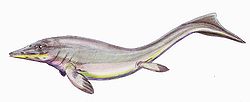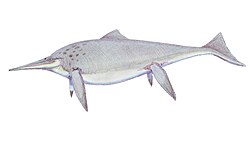History of study
Mollesaurus is known from the holotype MOZ 2282 V, articulated partial skeleton which preserved partial skull and most of the vertebral column. It was collected in the Chacaico Sur locality from the Emileia giebeli ammonoid zone of the Los Molles Formation, Cuyo Group, dating to the early Bajocian stage of the Middle Jurassic, about 171.6-170 million years ago. Mollesaurus, along with Chacaicosaurus cayi which was found at the same locality, are the only diagnostic ichthyosaur specimens from the Aalenian-Bathonian interval. It was found near Zapala city of the Neuquén Basin. [1]
Maisch and Matzke (2000) regarded Mollesaurus to be a species of Ophthalmosaurus . [2] However, all recent cladistic analyses found that Mollesaurus is a valid genus of ophthalmosaurid. [3] [4] Patrick S. Druckenmiller and Erin E. Maxwell (2010) found it to be the basalmost member of the ophthalmosaurid lineage that included Brachypterygius , Caypullisaurus and Platypterygius (but not Ophthalmosaurus). [3] Valentin Fischer, Michael W. Maisch, Darren Naish, Ralf Kosma, Jeff Liston, Ulrich Joger, Fritz J. Krüger, Judith Pardo Pérez, Jessica Tainsh and Robert M. Appleby (2012) found it to be the basalmost member of Ophthalmosaurinae. [5]
Phylogeny
The following cladogram shows a possible phylogenetic position of Mollesaurus in Ophthalmosauridae according to the analysis performed by Zverkov and Jacobs (2020). [6]
This page is based on this
Wikipedia article Text is available under the
CC BY-SA 4.0 license; additional terms may apply.
Images, videos and audio are available under their respective licenses.







